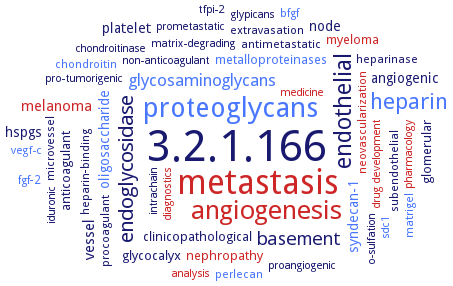3.2.1.166: heparanase
This is an abbreviated version!
For detailed information about heparanase, go to the full flat file.

Word Map on EC 3.2.1.166 
-
3.2.1.166
-
metastasis
-
proteoglycans
-
angiogenesis
-
endothelial
-
heparin
-
endoglycosidase
-
basement
-
glycosaminoglycans
-
melanoma
-
vessel
-
oligosaccharide
-
platelet
-
syndecan-1
-
hspgs
-
node
-
angiogenic
-
myeloma
-
nephropathy
-
anticoagulant
-
glycocalyx
-
clinicopathological
-
metalloproteinases
-
glomerular
-
procoagulant
-
heparin-binding
-
antimetastatic
-
heparinase
-
neovascularization
-
fgf-2
-
extravasation
-
bfgf
-
perlecan
-
subendothelial
-
matrigel
-
microvessel
-
chondroitin
-
pro-tumorigenic
-
o-sulfation
-
matrix-degrading
-
vegf-c
-
pharmacology
-
glypicans
-
diagnostics
-
proangiogenic
-
medicine
-
non-anticoagulant
-
iduronic
-
sdc1
-
prometastatic
-
chondroitinase
-
intrachain
-
drug development
-
tfpi-2
-
analysis
- 3.2.1.166
- metastasis
- proteoglycans
- angiogenesis
- endothelial
- heparin
-
endoglycosidase
-
basement
- glycosaminoglycans
- melanoma
- vessel
- oligosaccharide
- platelet
- syndecan-1
-
hspgs
- node
-
angiogenic
- myeloma
- nephropathy
-
anticoagulant
-
glycocalyx
-
clinicopathological
- metalloproteinases
- glomerular
-
procoagulant
-
heparin-binding
-
antimetastatic
- heparinase
- neovascularization
- fgf-2
-
extravasation
- bfgf
- perlecan
-
subendothelial
- matrigel
-
microvessel
- chondroitin
-
pro-tumorigenic
-
o-sulfation
-
matrix-degrading
- vegf-c
- pharmacology
-
glypicans
- diagnostics
-
proangiogenic
- medicine
-
non-anticoagulant
-
iduronic
- sdc1
-
prometastatic
- chondroitinase
-
intrachain
- drug development
-
tfpi-2
- analysis
Reaction
endohydrolysis of (1->4)-beta-D-glycosidic bonds of heparan sulfate chains in heparan sulfate proteoglycan =
Synonyms
BpHep, C1A heparanase, endo-beta-D-glucuronidase, endo-beta-glucuronidase, heparan sulfate glycosidase, heparanase, heparanase 1, heparanase-1, HPA, Hpa1, Hpa1 heparanase, HPSE, T5
ECTree
Advanced search results
Expression
Expression on EC 3.2.1.166 - heparanase
Please wait a moment until all data is loaded. This message will disappear when all data is loaded.
bovine serum albumin and advanced glycation end-product, but not high glucose levels, increase heparanase expression in adult tubular cells via the AKT/PI3K signaling pathway 1.68 and 2.81times, respectively
-
expression is up-regulated as tumors become more aggressive and is associated with enhanced tumor growth, angiogenesis, and metastasis
-
expression of the enzyme heparanase is clearly linked to colon carcinoma progression
-
heparanase expression is enhanced in almost all cancers examined including various carcinomas, sarcomas and hematological malignancies. Upregulation of heparanase expression correlates with increased tumor size, tumor angiogenesis, enhanced metastasis and poor prognosis. Heparanase is upregulated in response to chemotherapy in cancer patients and the surviving cells acquire chemoresistance, attributed, at least in part, to autophagy
heparanase is up-regulated in essentially all human tumors examined. Oxidized lipid- or angiotensin-induced expression of heparanase in macrophages may be a primary mechanism increasing heparanase in atherosclerotic plaques
-
heparanase variant T5 expression is up-regulated in 75% of human renal cell carcinoma biopsies
-
phorbol 12-myristate 13-acetate/calcium ionomycin stimulation results in a substantial increase in nuclear heparanase in the 53 kDa active form
-
sepsis-associated inflammatory lung disease causes rapid induction of heparanase activity through a TNFlpha-dependent mechanism in pulmonary microvascular endothelial cells. Heparanase induction is also found in biopsies of human inflammatory lung disease
-
the overall transcriptional activity of the main heparan sulfate biosynthesis-involved genes (EXT1, EXT2, NDST1, NDST2, GLCE, HS2ST1, HS3ST1, HS3ST2, HS6ST1, HS6ST2, SULF1, SULF2, HPSE) is decreased by 1.5-2fold in Grade II-III glioma (p < 0.01) and by 3-fold in Grade IV glioma (glioblastoma multiforme, GBM) (p < 0.05), as compared with the para-tumourous tissue


 results (
results ( results (
results ( top
top





